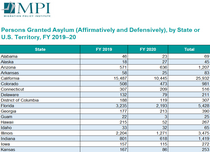The Missing Link: Connecting Eligible Asylees and Asylum Seekers with Benefits and Services
The United States has a long history of providing humanitarian protection, including by resettling refugees who seek protection from abroad and granting asylum to individuals who apply from within the country or at its borders. But even though refugees and asylees are granted protection after fleeing similar forms of harm and their status makes them eligible for many of the same public benefits and services, the system for connecting asylees with this support is much weaker than for refugees.
Multiple options exist under current law to improve asylees’ links to the benefits and services for which they are eligible, as this report explores, and doing so would help support asylees’ well-being and integration. The U.S. communities in which they live would also reap benefits from these investments as asylees upskill to meet staffing shortages, contribute to local economies, and become active members of their communities.
The situation for many asylum seekers is different. While they wait for their asylum cases to be decided—a process that can take several years, given the considerable backlog in immigration courts—they are typically eligible for far fewer public benefits. Nonetheless, support with navigating and accessing the limited programs for which they qualify can help ensure asylum seekers are able to meet their families’ basic needs.
This report describes the benefits and services for which asylees and asylum seekers are eligible, the mechanisms currently in place to connect them with these programs, and opportunities to improve their access to these forms of assistance.
1 Introduction
2 The Asylum Process in the United States
A. Employment Authorization
B. Policy Changes under the Trump and Biden Administrations
3 Trends in Asylum Claims and Asylum Processing
A. Trends in Asylum Grants
B. Characteristics of Asylees and Asylum Seekers
4 Benefits and Services Available to Asylees and Asylum Seekers
A. Benefits and Services from the State Department and ORR
B. Federal Public Benefits
C. Unemployment Insurance and Employment Services under the Workforce Innovation and Opportunity Act
D. Assistance to Children
E. State and Local Benefits
F. Tax Benefits
5 Participation in Federal Benefits and Services
6 Connecting Asylees with Benefits and Services
A. Proactive Outreach and Referral Hotlines
B. Benefits Orientations
C. Case Management
7 Connecting Asylum Seekers with Benefits and Services
A. Emergency Assistance
B. Integrated Legal and Support Services
8 Recommendations




